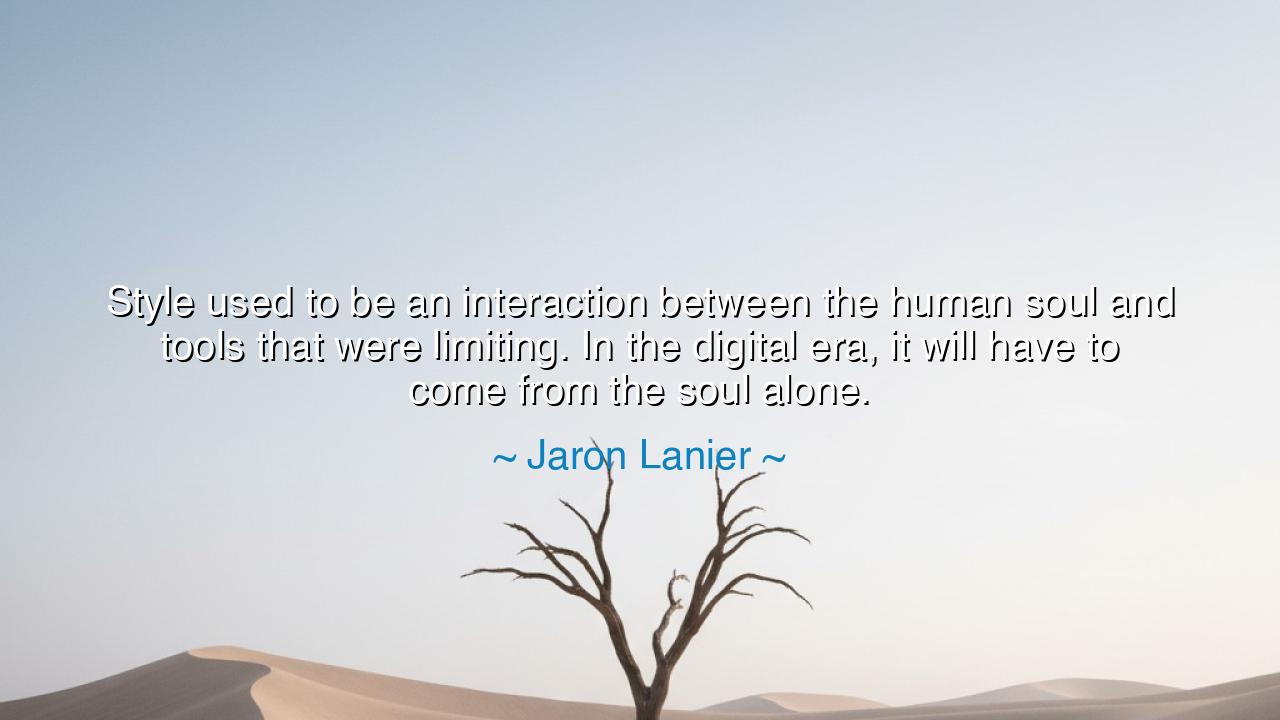
Style used to be an interaction between the human soul and tools
Style used to be an interaction between the human soul and tools that were limiting. In the digital era, it will have to come from the soul alone.






Hear the stirring wisdom of Jaron Lanier, prophet of the digital frontier, who declared: “Style used to be an interaction between the human soul and tools that were limiting. In the digital era, it will have to come from the soul alone.” These words strike like a bell across the chambers of art and creation, reminding us of how humanity has always wrestled with the boundaries of its tools—and how those boundaries once gave birth to the uniqueness of style.
In ages past, the painter was bound by the roughness of the brush, the scarcity of pigments, the grain of the canvas. The sculptor was constrained by the hardness of stone, the stubbornness of marble. The musician, too, was limited by the breath within his lungs, the length of strings, the imperfections of wood and metal. From these struggles between soul and tool, style was born. Michelangelo’s chisel marks, Beethoven’s furious notes, Van Gogh’s trembling brush strokes—all sprang from the dance between human spirit and earthly limitation.
But now, in the digital era, the boundaries dissolve. The painter’s digital brush may flow endlessly, the sculptor’s screen can shape with infinite precision, the musician’s software can conjure perfect sound without flaw or fatigue. The tools no longer resist; they yield completely. Yet in this very perfection lies danger. For if style once arose from the friction between the human and the material, then where shall it arise when the material no longer resists? Lanier’s warning is clear: now style must spring from the soul alone, from inner depth, not from outer struggle.
Consider the story of the photograph. When the camera was first born, critics feared it would kill painting. For what brush could rival the mechanical precision of the lens? Yet instead, painting was reborn. Freed from the task of mere representation, painters sought new ways to express the inner world: impressionism, cubism, abstraction. So too in our time: when the digital makes all styles available at once, when it offers perfection without effort, the true test of the artist is not the tool, but the authenticity of the vision within.
Lanier’s words also carry a heroic challenge. In this age where anyone may generate images, sounds, and texts without struggle, the temptation is to let the machine create in place of the soul. But then art becomes empty, a mirror without depth, a voice without breath. To create with true style today requires more courage than ever—to reach into the soul, to find meaning, to shape even limitless tools with the fire of human uniqueness.
The meaning, then, is both sorrowful and hopeful. Sorrowful, for the old dance between spirit and tool has ended; hopeful, for a greater responsibility has been laid upon the human heart. In the digital era, there is no longer the excuse of limitation. What you create must reveal not the tool’s resistance, but your own vision, your own voice, your own soul.
The lesson for us is clear: do not lean wholly on the perfection of machines. Do not let ease replace meaning, nor convenience replace authenticity. Cultivate your soul, deepen your vision, and let your style be born of inner fire rather than external constraint. Whether you paint, write, compose, or build, ask yourself: Does this reflect me, or only the tool I use?
Therefore, beloved seeker, take action. Embrace the digital, but root yourself in the eternal. Use the infinite powers of the screen, but let your style flow from the depths of who you are, not from the presets and templates offered by the machine. For in this way, you will honor Lanier’s teaching, becoming not only a user of tools, but a true creator—one whose soul alone gives shape to the age of the infinite.
And so, the words of Jaron Lanier endure as prophecy: “In the digital era, style will have to come from the soul alone.” Let them remind you that tools change, but the essence of creation does not. The flame of art, of expression, of humanity must always be kindled within, for without it, even the most powerful technology produces only silence.






AAdministratorAdministrator
Welcome, honored guests. Please leave a comment, we will respond soon